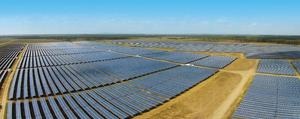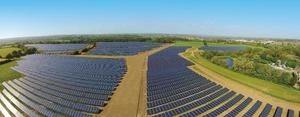The solar industry is one that never stands still, with innovations continuing to advance an increasingly mature industry. The latest projections by the IEA, state 70,000 solar panels will be installed every hour for the next five years. This is an industry which shows no signs of slowing down. As growth continues, the technology behind the panels continues to advance; digitalization, higher voltage inverters and the part to play of storage are areas in which companies across the industry are progressively looking to compete.
The inverter is arguably the most influential component of a solar plant with respect to uptime and reliability. As shown in the transition to 1000 Volts DC (VDC) whereby regulatory changes enabled the US market to switch away from 600VDC, higher voltage inverters are able to increase the cost efficiencies for a PV plant. Given the clear benefits of a higher voltage system, it would logically follow that the industry would continue to develop even higher voltage systems. However, while this has been the ambition, technological barriers have necessitated that this be an incremental process.
1500VDC is here
Nowadays, 1500VDC system is widely used in many regions and countries, like in Middle East, America, South America and many European countries like Spain and France. In fact, 1500VDC inverters are not something new, in 2016 we saw these projects beginning to come online as the technology gathered pace. These projects were first developed in Europe and were soon followed by efforts in the US and China. However, inverters present a challenge for manufacturers who need to meet customer demand for products that deliver high yield performance, reliably, while remaining cost effective. In 1500VDC inverters you have 50% longer strings and higher voltage than 1000VDC, which means 1500V inverters and enables it to present a lower cost to the consumer as the number of components and the labour cost is reduced.

Therefore while higher voltage inverters offer advantages, their inherent complexity – combined with technological challenges and market conditions – has meant that the path of development has been gradual, with the industry now enjoying the results inverters are capable of delivering. This development was particularly seen at Intersolar Europe 2018 with a number of companies opting to announce the new products as part of their offering, from the world’s most powerful inverter to more digitalised inverter solutions announced. Additionally, we have now seen utility scale projects such as the subsidy-free Don Rodrigo plant in Spain opting for Huawei 1500VDC inverters with their higher yields, smart operation and management as well as lower cost proving attractive.
Higher Voltage, Lower LCOE
It is therefore fair to say higher voltage brings a number of benefits to the PV plant, however it is also continued innovation in inverter technology in both efficiency and reliability that is becoming increasingly important as the global solar industry adapts to a world without subsidies.
Taking the UK as an example of a market where solar is adjusting to the end of state support, Anesco, a leading UK renewables developer, collaborated with Huawei to develop Clayhill, 10MW solar farm. Clayhill was the first solar project in Europe to use Huawei 1500V inverters, and the technology was cited by Anesco as being one of the key components of the project that enabled Clayhill to become the first subsidy-free solar farm in the UK, opened by Minister of State for Industry and Climate Change, Claire Perry, MP in September 2017.
Companies are also striving to advance these higher voltage inverters in order to improve string flexibility and maximise energy yields compared to traditional string or central inverters. Even since the Clayhill project, 1500VDC inverters have been improving with some inverters now featuring up to 6 MPPT per unit, meaning they are more adaptable to different layouts, it also means the inverters can perform better when faced with dust, cold weather or overcast days, resulting in a high EU efficiency of up to 98.8%. These improvements are helping developers to significantly lower LCOE, facilitating the delivery of more ground-breaking solar projects that are able to compete in a post-subsidy era with all forms of energy generation.
Innovation is vital
To continue driving the energy transition and to be able compete in a post-subsidy era against all forms of energy generation solar needs to be cost effective. The cost of solar as a technology is continuing to fall and according to Bloomberg New Energy Finance the cost of an average PV plant will have fallen by 71% in 2050. Therefore with the costs of physical components falling, companies will need to go even further in demonstrating how their own technologies can deliver cost efficiencies and ultimately how this can help them hold a competitive advantage.
Provide smart complete solutions
Higher voltage inverters are able to help this process by providing balance of costs savings, however one way in which companies are looking to hold this competitive advantage is to provide more than just 1500VDC inverters and to provide a more complete solution. We are seeing companies such as Huawei integrating inverter and transformer to provide a one-stop PV system solution. It is this bringing together of products which provides benefits in the construction period and reduces the overall cost.

Information technology, 5G and AI is now changing people’s life rapidly, making now the society more connected, digitized and smart. Solar industry is also in a rapid pace of being more digitized and smarter. While cost is one element behind constant innovation another reason, as seen across other industries, and increasingly now in the solar industry is digitalization which is beginning to play a much larger role. One way in which these two elements can be combined is through the development of smart, digitized inverters. The ability to be able to monitor and assess the performance of a plant remotely, reduces the need for an expert on site saving time and cost to assess the plant. This step-change in technology means zero-touch maintenance is now possible and with technologies such as Smart I-V Curve Diagnosis, issues with a PV plant can be observed and resolved quickly. This innovation also ensures a 100% string inspection and is able to auto diagnose in the event of a failure. What’s more, Smart I-V Curve Diagnosis can even predict the potential issue so that the maintenance people of a PV plant can even “solve the issue” before it happens.
All of these innovations are improving the efficiency of solar, enabling it to compete and prosper as part of the energy transition. With the speed of change gathering pace and digitalization playing a bigger part in the process, the importance of developing the inverter to an even higher voltage could be called into question.
What next for high voltage inverters?
However, it remains to be seen as to whether this transition for the solar industry to 1500VDC will be the last transition to a higher voltage. Companies are already exploring the possibility of 2000VDC and 3000VDC, however like in the transition to 1000VDC this is likely to be a gradual process. One thing that is clear for now is that 1500VDC are providing vast benefits as higher yields and digitized management, meeting the needs of customers, offering reduced costs in a critical time for the industry as it moves beyond subsidies and into competing against all forms of generation and making it truly a Smart PV era. (HCN)
Discover more of Huawei`s innovations on video from our pv Guided Tours at The smarter E Europe
Stay informed, get our free newsletter twice a week for free. Subcribe here
https://www.pveurope.eu/News/Energy-Storage/BYD-launches-modular-high-voltage-energy-storage-system







